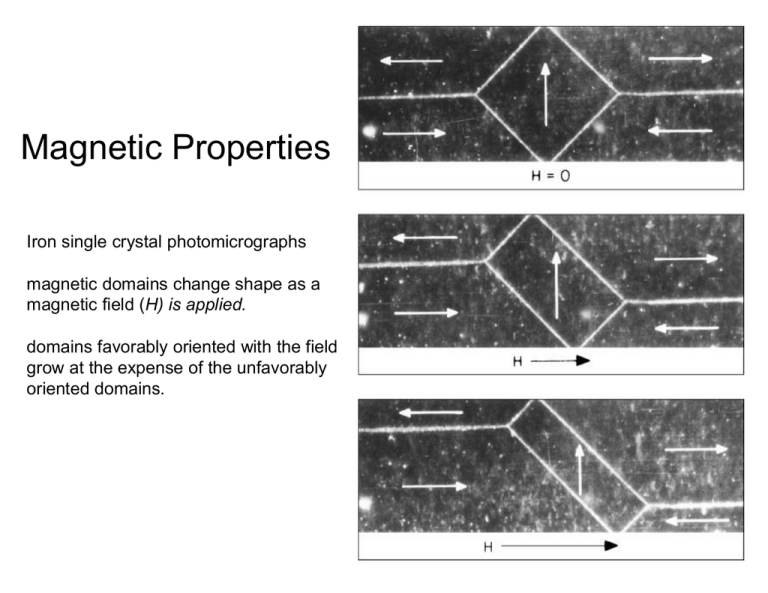Magnetic properties
advertisement

Magnetic Properties Iron single crystal photomicrographs magnetic domains change shape as a magnetic field (H) is applied. domains favorably oriented with the field grow at the expense of the unfavorably oriented domains. 18.2 Basic Concepts Magnetic forces appear when moving charges Forces can be represented by imaginary lines grouped as fields c18f01 Magnetic field lines of force around a current loop and a bar magnet. MAGNETIC DIPOLES The magnetic moment represented by a vector Magnetic Field Vectors magnetic field strength (H) & magnetic flux density (B) Magnetic flux density B = H B0 = 0 H relative permeability r = 0 magnetization B = 0 H + 0 M M = m H NI Magnetic field strength H = l c18f03 magnetic susceptibility m = r - 1 Origins of Magnetic Moments: Responds to quantum mechanics laws Two main contributions: (a) an orbiting electron and (b) electron spin. Bohr magneton (B) Most fundamental magnetic moment B = ±9.27x10-24 A-m2 The spin is an intrinsic property of the electron and it is not due to its rotation 18.3 Diamagnetism and Paramagnetism Diamagnetic material in the presence of a field, dipoles are induced and aligned opposite to the field direction. c18f05 Paramagnetic material B = 0H + 0 M = 0H + 0 mH The flux density B versus the magnetic field strength H for diamagnetic and paramagnetic materials. c18f06 = 0 (1 + m) c18tf02 18.4 FERROMAGNETISM mutual alignment of atomic dipoles even in the absence of an external magnetic field. coupling forces align the magnetic spins B = 0 H + 0 M B 0 M Domains with mutual spin alignment B grows up to a saturation magnetization Ms with a saturation flux Bs = Matom × Natoms (average moment per atom times density of atoms) Matom = 2.22B, 1.72B, 0.60B for Fe, Co, Ni, respectively 18.5 Antiferromagnetism & Ferrimagnetism ANTIFERROMAGNETISM Antiparallel alignment of spin magnetic moments for antiferromagnetic manganese oxide (MnO) 1986: superconductivity discovered in layered compound La2-xBaxCuO4 with a transition T much higher than expected. Little was known about copper oxides At low T Above the Neel temperature they become paramagnetic c18f08 Parent materials, La2CuO4, and YBa2Cu3O6, demonstrated that the CuO2 planes exhibit antiferromagnetic order. This work initiated a continuing exploration of magnetic excitations in copper-oxide superconductors, crucial to the mechanism of high-temperature superconductivity. FERRIMAGNETISM spin magnetic moment configuration for Fe2+ and Fe3+ ions in Fe3O4. Above the Curie temperature becomes paramagnetic 18tf03 In our textbook 2.22, 1.72, 0.61 18.6 The Influence of Temperature on magnetic Behavior TC: Curie temperature (ferromagnetic, ferrimagnetic) TN: Neel temperature (antiferromagnetic) material become paramagnetic 18.7 Domains and Hysteresis Domains in a ferromagnetic or ferrimagnetic material; arrows represent atomic magnetic dipoles. Within each domain, all dipoles are aligned, whereas the direction of alignment varies from one domain to another. Gradual change in magnetic dipole orientation across a domain wall. c18f11 c18f12 B versus H ferromagnetic or ferrimagnetic material initially unmagnetized Saturation flux density, Bs Magnetization, Ms, initial permeability i c18f13 Domain configurations during several stages of magnetization Magnetic flux density versus magnetic field strength ferromagnetic material subjected to forward and reverse saturations (S & S’). hysteresis loop (red) initial magnetization (blue) remanence, Br coercive force, Hc c18f14 Comparison magnetic versus nonmagnetic c18f16 18.12 Superconductivity Temperature dependence of the electrical resistivity for normally conducting and superconducting materials in the vicinity of 0 K. Critical temperature, current density, and magnetic field boundary separating superconducting and normal conducting states (schematic). c18f27 Representation of the Meissner effect. While in the superconducting state, a body of material (circle) excludes a magnetic field (arrows) from its interior. The magnetic field penetrates the same body of material once it becomes normally conductive. c18tf07 SUMMARY • A magnetic field can be produced by: --putting a current through a coil. • Magnetic induction: --occurs when a material is subjected to a magnetic field. --is a change in magnetic moment from electrons. • Types of material response to a field are: --ferri- or ferro-magnetic (large magnetic induction) --paramagnetic (poor magnetic induction) --diamagnetic (opposing magnetic moment) • Hard magnets: large coercivity. • Soft magnets: small coercivity. • Magnetic storage media: --particulate g-Fe2O3 in polymeric film (tape or floppy) --thin film CoPtCr or CoCrTa on glass disk (hard drive) 10




